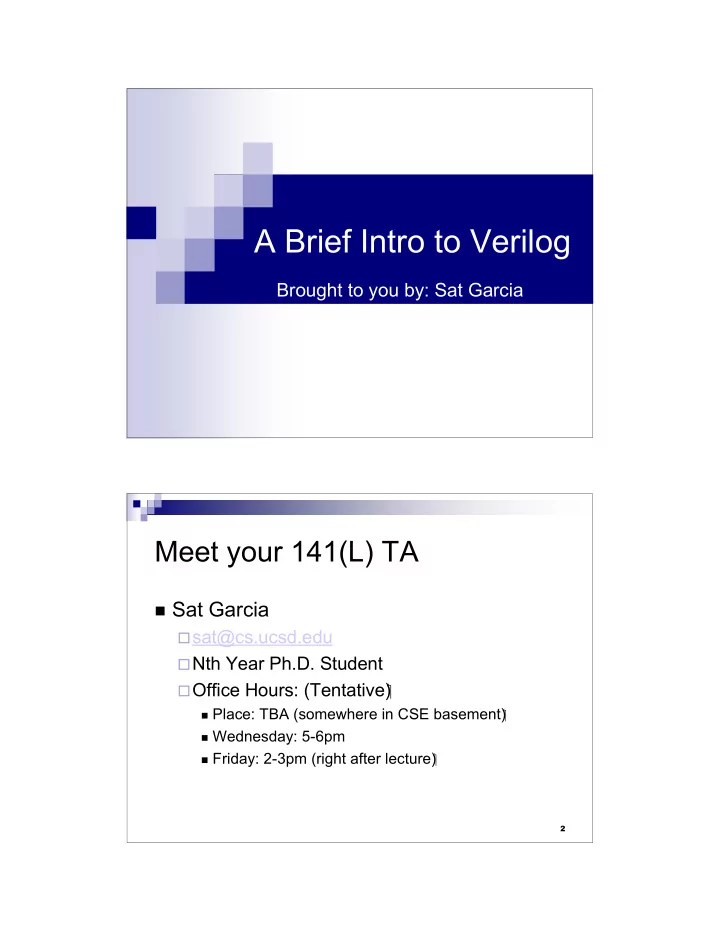

A Brief Intro to Verilog Brought to you by: Sat Garcia Meet your 141(L) TA Sat Garcia sat@cs.ucsd.edu Nth Year Ph.D. Student Office Hours: (Tentative) Place: TBA (somewhere in CSE basement) Wednesday: 5-6pm Friday: 2-3pm (right after lecture) 2 1
What is Verilog? Verilog is: A hardware design language (HDL) Tool for specifying hardware circuits Also for simulating circuits Syntactically, a lot like C or Java An alternative to VHDL (and more widely used) What you'll be using in 141L Awesome 3 * If you are totally into hardware design languages Verilog in the Design Process Behavioral Test Algorithm Results Manual Simulate Test Register Results Transfer Level Logic Synthesis Simulate Test Gate Level Results Auto Place + Route Adapted from Arvind & Asanovic’s MIT 6.375 lecture 4 2
Styles of Verilog RTL Specific description on how module operates Adds, shifts, etc. Structural Describe how modules connect together Instantiate modules written in RTL and wire them together Behavioral High level description of what module is doing Looks a lot like C++ or Java Not always synthesizable If it is, it is probably inefficient 5 A simple example (comb. circuit) Let's design a 1 bit full adder (RTL style) a b module FA( input a, b, cin, output s, cout); cin assign s = a ^ b ^ c; FA assign cout = (a & b) | (a & cin) | (b & cin); cout endmodule s *** Note: red means new concept, blue and green are just pretty colors :-p Ok, but what if we want more than 1 bit FA? Adapted from Arvind & Asanovic’s MIT 6.375 lecture 6 3
A 4-bit Full Adder We can use 1 bit FA to build a 4 bit full adder FA FA FA FA Structural style module 4bitFA( input [3:0] A, B, input cin, output [3:0] S, output cout); wire c0, c1, c2; FA fa0(A[0],B[0],cin,S[0],c0); // implicit binding FA fa1(.a(A[1]), .b(B[1]), .cin(c0), .s(S[1]), .cout(c1)); // explicit binding (use this!) FA fa2(A[2],B[2],c1,S[2],c2); FA fa3(A[3],B[3],c2,S[3],cout); endmodule Adapted from Arvind & Asanovic’s MIT 6.375 lecture 7 A simple D flip flop (seq. circuit) For sequential circuits, use always blocks Always blocks (and assign) are executed in parallel! module DFF( input clk, d, output q, q_bar); reg q, q_bar; always @ (posedge clk) // triggered on the rising edge of the clock begin q <= d; // non-blocking assignment (LHS not updated until later) q_bar <= ~d; /* q_bar <= ~q will not function correctly! Why not? */ end endmodule Adapted from Arvind & Asanovic’s MIT 6.375 lecture 8 4
Recommend
More recommend